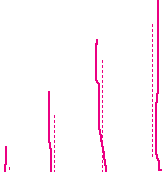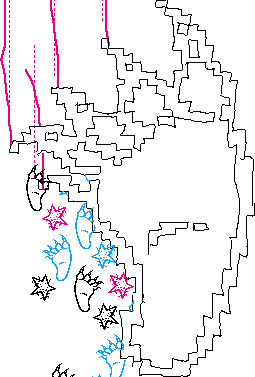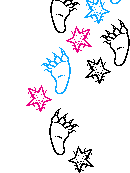| (1) GENERATION FLASH (2) FAQ (3) UTOPIA IN SOFWARE (4) THE UNBEARABLE LIGHTNESS OF FLASH (5) ART, MEDIA AND SOFTWARE ART (6) POSTSCRIPT LEV MANOVICH, 2002 (7) WEBSITES, THE ART OF OUR TIMES MILTOS MANETAS , 2002 (8) FLASH IS POPTECH PETER LUNENFELD, 2001
Websites, the art of our times. by Miltos Manetas
Websites are today's most radical and important art objects. Because Internet is not just another "media", as the Old media advertises, but it is a space,similar to the American Continent immediately after it has been discovered, anything that can be found on the web, has a physical presence: it occupies real estate. To encounter a logo, a picture or an animation in the Internet, is a totally different experience than to find the same stuff between the pages of a magazine or on television. "Things" in the Internet, exist in a specific location. While in magazines and TV, contents are bullets of information, online they constitute a body : they are parts of a new type of entities. Such entities, may include humans or being entirely robotic: made by software, like Google, which is a search engine. Web entities, usually get in touch , they advertise their existence to each other. As any human entities would do, they evaluate , criticize, even "link" to each other and they ultimately develop a "taste". Bob Dobbs ( a friend of Mc Luhan) said that "advertising is communication between machines" . He also suggested, that machines came alive in 1967 and that "now they are in an angelic state". According to him, "advertising is communication between angels". It is not strange then, that we start encounter "art" which is not made by human artists, but it originates from the attempts of these entities - or "angels"- to communicate in a pretty way. Therefore, to paint the portrait of a Google logo, is more similar to the making of a portrait of Christopher Columbus, or to the composition of a historical event such as the French Revolution was for J.L David, than to a pop depiction of a Coca Cola bottle. Taking snapshots of webpages is observing how those entities behave and it is also searching for a new kind of beauty. Nobody knows how the next page will look like, simply because it is not yet registered ! There is no tradition, no academy, it doesn't even exist any real Internet society yet: just lonely pairs of fingers and eyeballs which are looking, while others pairs are showing them whatever happens to land over their imagination. The Art World instead, is the opposite. It is collected around a few cities, such as New York and London, it uses powerful tools such as the Art Magazines, to impose centralization, it respects timed reoccurring events - the large international exhibitions and the artfairs, it has a bureaucracy -the Museums - and a theology - the wonder of the human genius. While there are still a few interesting artists who operate outside of the Internet, it is impossible for them to make something really different happen there, because the "real" artworld is such a stabilized and saturated environment. Outside of the Internet, there's no glory. Non-Internet artists, are just some freelance employees of other employees (the curators of the exhibitions). To work for somebody else, is not necessarily a problem, that's after all how, different beautiful "Jesus and Madonna" pictures have been produced in the past. The problem starts instead , when your commissioner doesn't have a clue of what he/she wants from you. Art curators and people that commission art today, usually don't ask for anything specific from the artists that they choose, other than to prove for one more time, what they, (the artists), are already known for. Because institutions bestows these curators with confidence and power, they are chasing the opportunity of creating the art by themselves, by putting the artists together. They are not looking for unseen objects but for some evidence of human expression, which they will bring back to their commissioners as a well trained dog would do with its ball. They are just sampling stories... No wonder then, that any top level art exhibitions such as the Whitney Biennial, the Documenta in Kassel the Manifesta and the Venice Biennial, all look like the graduation day for students of anthropology. In these exhibitions, any realistic representation could as well be used as an illustration for the National Geographic while any abstract piece becomes mere decoration. "It's interesting..." The art of the past century was based mostly on "the following principle: ""if you put something in an empty room, it seems strange and significant ". A variation of that, was "" if you take something out of its context, it seems strange and significant "", and another "" if you change the scale of something, it will seem strange and significant "" , and a last one : "" if you multiply something it also becomes strange and significant "". But after 80 years of different combinations, for any kind of objects inside the hopelessly empty spaces of our art institutions, nothing seems interesting. Unfortunately, we can now see clearly, that the supposed "art" is simply a bunch of trash or just some products bought in a mall or a photo illustration. They are usually ugly artifacts. We immediately recognize them as contemporary art ( but only when we find them in the right place ). Art public is open to anything, because it knows that nothing peculiar will ever happen. Even if we will leave the gallery empty, the public will search for the label with the name of the artist who did the "work" and it will be satisfied one way or another. Real Space, has lost its emptiness. But in the Internet, where the space is created by software and random imagination, an empty webpage is really empty. People, can still produce unpredictable objects to put there. " Telic and Neen " . Telic, is a word produced by a branding company . ( Lexicon, the creators of terms such as "powerbook" and "pentium". It stands for anything related with computer technology , from Wired Magazine type of ideas and lifestyle to art generated with computers and theory about machines, software and robots. Telic is super creative, sometimes in a paranoid way : its more creative than what it worths to be, because it is using creativity as a power engine to examine the landscape. Telic is serious . It will explain every little detail. It will submit lots of footnotes and references. It will be "open form" and it will accept updates from anyone. Telic is never snob and it is indifferent to style or it will overdo with it similar to a New Jersey boy who comes in Manhattan on Friday nights. San Francisco, is in this sense, the Telic capital of the World. Telic authors and artists, usually teach in Universities . They survive thanks to the grants that other Telic people are managing and they avoid the artworld, which in return, also ignores them. But Telic shapes the World. As J.G Ballard wrote " Science and technology, multiply around us. To an increasing extend they dictate the languages in which we speak and think. Either we use those languages, or we remain mute". Telic is making sense from these languages, but then, do we really want to make sense ? Why shall we be so domesticated and so productive ? Why our "design" becomes sometimes so irrelevant that even the most boring companies are comfortable to sponsor it and use it as their banner? Here it where Neen comes in, another name invented by Lexicon. Neen is the crazy little brother. What it does, may sound sometimes stupid , but only because its easy and amazing. A Neenster, is not a wannabe, he/she doesn't suffer of any sense of duty, but he/she will use culture the same, as an occasion to exercise his/her brain. The dream of a Neenster, is to become an icon and usually starts his career by becoming the icon of his own imagination. Then, he projects it to the outside as if it were a fact. Identity, is not a priority for a Neenster, but one will fetishize oneself anyway and use that as a style: it's a fast way to produce content. But a Neenster , in contrast with contemporary artists, will change identities often, according to the situations: Neen, is ultimately a state of mind. People such as Lucio Fontana, who were doing painting by simply slashing a canvas, were Neen before Neen. A few videogames, the most untelic ones, such as Animal Leader for Nintendo Cube, is for a Neenster a good thing to do when he is tired from his usual job, which is namely doing nothing: not even consuming. Because the Internet is the best place to exercise your "non activity", Neensters use to spend a lot of time online. They are Friends of the information and not Users as the Telic people and because they need something that simulates social battle they participate actively in the intellectual property and copyright war. They watch the data population, music, images,ideas and texts, while it struggles to get free from the slavery of the intellectual property and copyright. Their are spending months downloading anything that they can find, from songs to porn movies and books just for the pleasure of copy. Then, they will put copies of what they copied online, for others to copy. Neensters, are also obsessed with names. They will run a search in the Internet to see if the domain with a new name they envisioned is available, if it is, they will register it. Immediately after, they'll do something fresh and they"ll put it online: it will not be your father's website with the usual links , info and stuff, it will be something minimal and straightforward. Neensters, will let the page to be what it must be : a new art object. "Collectors" A work of art, comes to the World, because of its creator, but it survives only because of the collector who will take care of it. In terms of Neen, a collector, is even more important than the artist himself, because he "does" art with less effort. Collecting, is the power to decide if a piece should continue exist or not: once you own it, you can decide if destroy or conserve it. Never this power has been more significant, than for a collector of websites: if he will not pay the hosting fee, the work will disappear. The name of the website will return to the pool of the available domain names. The whole piece will expire as it has never existed. You can burn a painting, but it's photograph will always permit people to reproduce it. It's not the same with the website though. A website is the ultimate property. You don't experience it only with your eyes but also with your fingers, which are driving your mouse somewhere. It is a trip to a secret Villa, you have to open the door and confront yourself with something that's already there. If a collector will decide to keep this experience just to himself, he will put a password on the page and nobody will be able to access it. He will lock the Villa, keep the art a secret. The collector of a website has total control, because the art in a website, is not the animation, or the code, or the picture that the website contain, but the possibility to experience it in a unique place , under a unique .com , .net or .org . No magazine can pass you the idea, no picture can inform you about the content of that type of art. You simply have to click on it and the collector is the one who decides if you can do that. Very few people yet, are cool enough to collect websites. It is a difficult thing and it requires intuition and courage. Its similar to the purchase of a nice apartment in a ghetto area of Harlem. Anybody instead, can walk into a Gagosian or Jeffrey Deitch gallery and buy some contemporary art . It's as easy, as buying designer clothes: the House which sell the product , guarantee its value and you get what you pay for : a giant certificate of authenticity with some picture on the front . When you buy contemporary art, you buy a copy of what belongs already in a museum , because contemporary art museums are made specifically for this type of art and will eventually host anything produced by the major galleries. It's an industry of memorabilia. Collecting in this case is not an adventure, but its like opening another Savings Account which awards you with its little interest. Larry Gagosian indeed call his collectors "customers". "neen professionals" A job is : 1. A regular activity performed in exchange for payment, especially as one's trade, occupation, or profession. 2. A position in which one is employed. 3. a) A task that must be done: Washing the windows is not my job. b) A specified duty or responsibility While contemporary artists are suffering from a heavy complex, in relationship with the idea of job, a complex which makes them pretend that they are either working class proletarians or smart alecs is a permanent vacation, Telic people accept stoically that they must have a job and even that they have to finance their research by themselves! Both, see the art they produce, as "their art", a personal affair, their "mission" . Neensters instead, are against the very concept of job: they are just too shiny themselves to obey any other's orders , too embarrassed to play the clown that the contemporary artist's profile requires. Some Neensters doesn't even want to produce any objects at all, they are the relatives to the art critics, the curators and the gallerists of the art world. They will make the ideas of others possible, pretty much as the art professionals would. They will write about what they see around. They will even make business and sell art . But they will serve nobody. Their act will seam incoherent and suspicious. Their taste will not be predictable and the rest of the traditional art workers will envy them because of their force. They will sell pieces, but as a favor they do to the people who buy: to help them get rid of some money , give them a chance of a perceptive. For these Neen faux- professionals, money , seam to fall from the sky . They will always know how to turn it into clouds and make it fall again like rain , in random places. They will also be brilliant personalities and they will always have a nice name. In fact, in such an after computer World we live today, words and names seam to be the karma of everything. It is possible to change your destiny, by simply renaming it. Neen professionals, are doing exactly that for a job. To be continued
|
![]()
 |
 |
 |